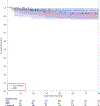Outcomes of carotid-sparing IMRT for T1 glottic cancer: Comparison with conventional radiation
- PMID: 30756394
- PMCID: PMC6895404
- DOI: 10.1002/lary.27873
Outcomes of carotid-sparing IMRT for T1 glottic cancer: Comparison with conventional radiation
Abstract
Objectives: We aim to report oncologic outcomes after conventional radiotherapy (ConRT) using opposed lateral beams and intensity-modulated radiation therapy (IMRT) for tumor (T)1 nodal (N)0 T1 N0 glottic squamous cell carcinoma.
Study design: Retrospective case-control study.
Methods: We retrospectively reviewed demographic, disease, and treatment characteristics for patients treated at our institution during 2000 to 2013.
Results: One hundred fifty-three patients (71%) were treated using ConRT and 62 (29%) using IMRT. The median follow-up for all patients was 68 months. There was no statistically significant difference in 5-year local control between patients with T1a versus T1b disease (94% vs. 89%, respectively, P = 0.5). Three-year locoregional control for patients treated with ConRT was 94% compared to 97% with IMRT (P = 0.4). Three-year overall survival (OS) for patients treated with ConRT was 92.5% compared with 100% with IMRT (P = 0.1). Twelve of 14 patients with local recurrence underwent salvage surgery with 5-year ultimate locoregional control of 98.5% and 97.1% in the ConRT and IMRT cohorts, respectively (P = 0.7). Multivariate analysis showed age < 60 years (P < 0.0001) and pretreatment Eastern Cooperative Oncology Group performance status <2 (P = 0.0022) to be independent correlates of improved OS. Postradiation cerebrovascular events were in four patients in the ConRT cohort (3%), whereas no patients in the IMRT cohort suffered any events.
Conclusion: Because the oncologic outcomes for patients treated with IMRT were excellent and IMRT allows for carotid sparing, we have transitioned to IMRT as our standard for most patients with T1 glottic cancer.
Level of evidence: 3b Laryngoscope, 130:146-153, 2020.
Keywords: IMRT; T1 glottic squamous cell carcinoma; larynx cancer; oncologic outcomes; radiation therapy.
© 2019 The American Laryngological, Rhinological and Otological Society, Inc.
Figures
References
-
- Chera BS, Amdur RJ, Morris CG, Kirwan JM, Mendenhall WM. T1N0 to T2N0 squamous cell carcinoma of the glottic larynx treated with definitive radiotherapy. Int J Radiat Oncol Biol Phys 2010;78(2):461–6. - PubMed
Publication types
MeSH terms
Grants and funding
LinkOut - more resources
Full Text Sources
Research Materials



